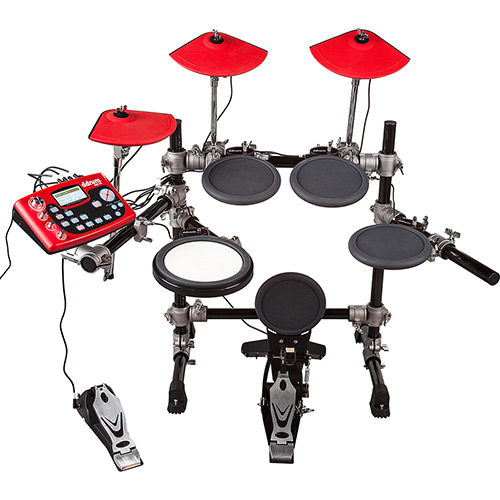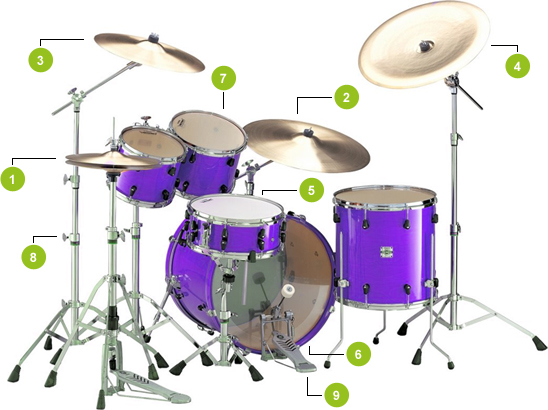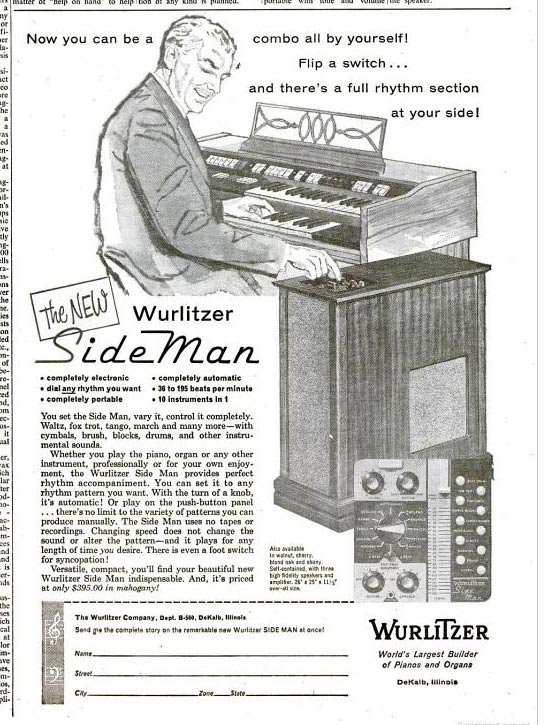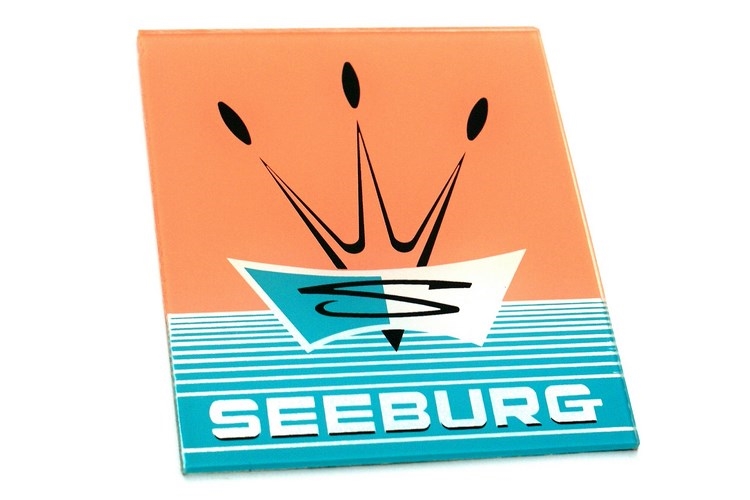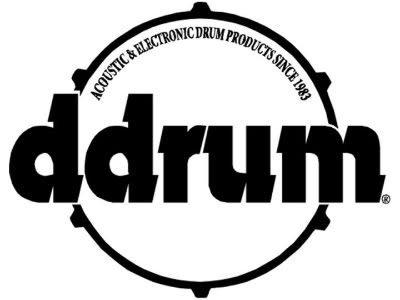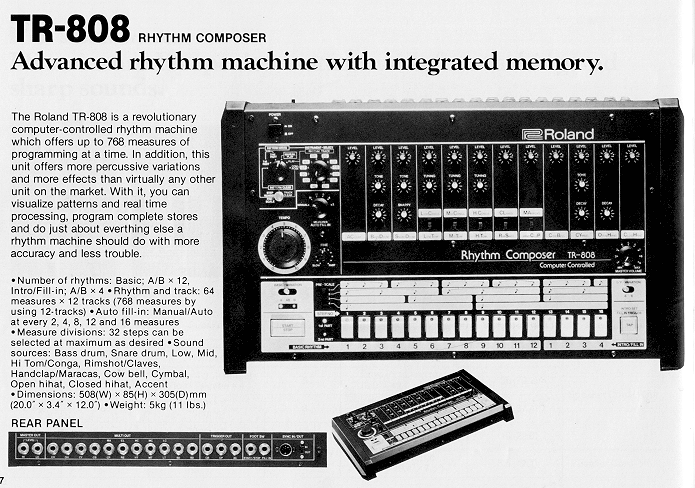Drums & Rhythm Boxes
A fully digitized drumkit (ddrum, model DD1)
In the series about rock music hardware, we take a look at the drum kit & the rhythmbox.
Technical and musical greetings from
Kurt Starlit
- aka CykelKurt
This series includes:
Latest update: 2016.March.22
+++++++++++++++++++++++++++++++++++
The mechanical drum kit
From the beginning drums were purely mechanical, that is without electronics of any kind. They were intended to be used when marching, for example the bass drum to this day is carried in a harness on the chest.
When jazz appears around year 1900, all music-making works in the same way as the military: in march (Dixieland or New Orleans style). A marching drum kit is served by several musicians, each with his instrument (bass drum, snare drum, cymbals etc.). In this way, drums are carried in belts up to 1920, when the regular jazz bands appear on the scene.
Around this time various pubs in major cities begin to hire jazz orchestras, which at this time is the new trend. First of all this means, that the days of marching is over. Instead, the drum kit is placed on the stage floor, played by just one drummer. In this way he is controlling all parts of the drum kit - a development that has continued ever since.
A drum kit is a set-up of drums, cymbals and other percussion to fulfill the drummer's wishes and needs.
Some time around 1955 the new musical trend "rock 'n' roll" emerges, where the leading drum manufacturers are Ludwig, Gretsch and Slingerland.
The drums are still completely mechanical, no electronics are used.
A drum kit is made by a variable number of drums, each with its own special function. Each drummer adjusts the size of his drum kit from playing style and personal taste.
A standard rock drum kit.
See text below, where different parts of a drum kit is explained.
1. Hi-hat
A hi-hat consists of two cymbals crashed against eah other by means of a foot pedal. If you hit a closed hi-hat with a drumstick, you'll hear a short click. If you hit an open hi-hat with a drumstick, you'll hear a longer ringing sound. The standard diameter of a hi-hat is 14" (36 cm).
2. Ride cymbal
The most important purpose of a ride cymbal is to keep the rhythm - "to ride a steady rhythm," as they say. Ride cymbal is also used as an alternative to the hi-hat. Sometimes it is even used as a crash cymbal, depending on alloy and thickness of the ride cymbal. The ride cymbal is also sometimes referred to as a Rhythm Cymbal. The most common diameter of a ride cymbal is 20" (51 cm).
3. Crash cymbal
The crash cymbal is used for marking periods in the music or to make an instrumental emphasis, e.g. a brass riff or a rhytmic marking. The size of a crash cymbal varies according to personal taste or musical genre.
4. China cymbal
A China cymbal has got the same function as a crash cymbal, but its sound is a bit different. It reminds more of a gong, which is relatively often used within rock music.
5. Snare drum
The snare drum may be made of wood, which gives a softer sound, or brass, which gives a more "singing" sound. It is usually 14" (56 cm) in diameter and 5-6" deep. The top skin is coated, which means there is a coating on the skin. An unusual property of the snare drum is, that it has got a set of metal wires (or springs) at the bottom called "the snares". They are mounted in such a way, that they touch the bottom skin of the snare drum (called "the snare head"). When hitting the top skin (called "the batter head"), the snares are vibrating against the bottom skin, causing the snare drum to deliver a sharp timbre.
6. Bass drum
The bass drum is called the heart of a drum kit, because it creates the basic rhythm. It has got the deepest sound and is the largest drum of the drum kit. The bass drum stands directly on the floor, and is operated by foot by means of a special bass drum pedal. The size of a bass drum depends on the type of music being played. The rock musician usually prefers 22", 24" or 26" (66 cm). The jazz musician, playing a softer genre, usually prefers 18" or 20" (51 cm). The most common size of a bass drum is 22" (56 cm) as it is usable for most genres.
7. Tom-tom
Size and number of toms is depending on musical genre and playing style. A rock drummer often prefer to have many large (deep-sounding) toms, where a jazz drummer prefers two high-pitched toms, providing a bright ringing sound. A tom-tom can be mounted EITHER on the bass drum, called "hanging toms", or they can be stand-alone units with three or four legs - called "floor toms".
8. Cymbal stand
Stands are necessary to keep various cymbals in place. We are talking about e.g. a crash cymbal stand, a ride cymbal stand or a high-hat stand. A high-hat stand is a bit more complicated than the rest, since it has got a pedal at the bottom, which is required to open and close the high-hat. All cymbal stands are height-adjustable. Furthermore, it is often possible to adjust the angle of the cymbal. The snare drum stand is used to keep the drum in a desired height and position (angle), in this way suiting each drummer individually.
9. Bass drum pedal
The bass drum pedal is used to beat the bass drum. This is done by pressing down the pedal with your foot. With this pedal you can - among others - regulate hardness of the attack and distance to the bass drum, to find just the right setting that suits the individual drummer. A number of rock-drummers are using a double bass drum pedal, to play faster (more strokes) on the bass drum - or drums
(find further info on the bass drum pedal under Bass drum.)
+++++++++++++++++++++++++++++++++++
The Rhythm Box
The first rhythm box is popping up in 1931, but is not very useful from a musical point of view. For this reason, we need to jump to 1955, before a reasonable rhythm box aimed at musicians, is launched.
The purpose of a rhythm box is to imitate the sound of natural drums. The drummer and his drum kit in this way is becoming useless. You could imagine the rhythm box as an electronically controlled drum kit. Moreover, the controller don't have to be a real drummer, but can be done by anyone with a little musical flair.
The rhythm box has got various other names, e.g.
drum machine,
rhythm machine, or plainly
machine.
The designations will be used at random on this site.
+++++++++++++++++++++++++++++++++++
The world's first rhythm machine, Rhytmicon (also called Polyrhythmophone), appears in 1931, having a lot in common with the Theremin.
The sound is generated by radio-tubes, which at this time have become common. From a small keyboard, the electronics are activated, and the desired tone is repeated in a regular rhythm, as long as the key is held down. The rhythm is created by a rotating plate with holes through which a number of small bulbs illuminates (= activates) photo-electric cells. These cells are part of the oscillator circuit of the tubes - and thus determines the speed of the rhythm.
Despite Rhytmicon being far ahead of its time, it didn't last long. After a few years, the inventors lost interest, and Rhytmicon was withdrawn.
Rhytmicon demonstration
+++++++++++++++++++++++++++++++++++
This rhythm machine was launched in 1957. It consists of 14 endless tape-loops with 3 tracks each (= 42 different tape-loops or rhythms). A switching system makes it possible to play each of the 42 tracks separately - or a mixture from ones own choice.
Rhythmate is equipped with volume- and speed control as well as a separate amplifier with bass, treble and volume control. The machine has a jack input for guitar, microphone or other instrument. The tape loops are recordings of real drums, playing different styles.
A special twist of the story of Chamberlin's tape machine is that one of his employees (his name was Franson) took the Rhythmate to England, where he renamed it to Mellotron, started his own business (Streetly Electronics) and launched the Mellotron. It sold very well, e.g. the Mellotron was used heavily by The Moody Blues on their hit record, "Nights in White Satin"
At home in the USA, Chamberlin heard it through the grapewine about the English project. The was a lot of fuss, but the bottom line was an agreement that the Mellotron had to be sold exclusively i England, and Rhythmate exclusively in the US. Furthermore, Chamberlin also received commission from Mellotrones sold in England.
With this agreement settled, Franson was legally permitted to use the tape-loop called "3 Violins". In the years ahead, this sound became a trademark of Mellotron. For the same reason it may be difficult to determine wheather a recording of "3 Violins" is made by the Rhythmate or the Mellotron. One must actually know the country in which recording is made, to settle the matter.
M400D Digital Mellotron (launched 2010)
+++++++++++++++++++++++++++++++++++
Billboard ad, May 1960
Wurlitzer Sideman appears in 1959 and is considered to be the world's first commercially produced rhythm box. Sideman was intended as a rhythmic accessory to the company's organs. It contained a selection of 12 electronically generated and predetermined rhythms with a variable tempo. The sounds were created by means of a number of oscillators (with tubes and valves), which could generate 10 different drum sounds.
Sideman was equipped with a panel of 10 buttons to control the drum sounds manually, and was moreover equipped with a remote control, making it possibly to control the rhythm box while playing the organ.
+++++++++++++++++++++++++++++++++++
Rhythm Synthesizer
In 1960, Raymond Scott launches a so-called Rhythm Synthesizer and in 1963 a rhythm box called Bandito the Bongo Artist.
Both machines are being used during the recording of his three solo albums from 1964:
"Soothing Sounds for Baby" vol. 1
+++++++++++++++++++++++++++++++++++
Up through the 1960s, tubes and valves are gradually fading from production. Instead, rhythm boxes are equipped with transistors (also called solid state).
At the same time, the physical size of a rhythm box goes down. Where it had previously required a location on the floor, it can now easily stand on a table.
In 1964, Seeburg develops a compact rhythm-pattern generator. It consists of a diode matrix, using small LEDs to create the many connections necessary to generate a pattern.
Select-A-Rhythm (SAR1) is launched in 1965.
+++++++++++++++++++++++++++++++++++
Ace Tone
In 1965, Nippon Columbia apply for a patent on an automatic rhythm box, and in 1967 mr. Kakehashi (founder of Ace Tone and Roland Corporation) develops a pre-programmed rhythm machine, that uses a diode matrix circuit, which is a little reminiscent of Seeburg.
Ace Tone, model FR-1 Rhythm Ace is launched in 1967.
+++++++++++++++++++++++++++++++++++
The first recordings
A significant number of new new rhythm boxes were sent on the market in the 1970s. Some of these were used at recordings. The first major pop song using a drum machine is Robin Gibb with "Saved by the Bell". It reached to number two at the British charts in 1969.
Likewise, a rhythm box was used on Sly & The Family Stone album "There's a Riot Goin' On", which was released 1971.
Another early example of recordings with electronic drums is "Obscured by Clouds" by Pink Floyd in 1972.
The first album with drums played exclusively by a machine, is the group Kingdom Come with the album "Journey", recorded in November 1972. The drumming was performed by a Bentley Rhythm Ace machine.
+++++++++++++++++++++++++++++++++++
Drum synth
In the mid-1970s, the first drum synthesizer is lauched. It is not an independent set of drums, but rather an accessory to the mechanical drums, adding some synthetic sounds to the well-known acoustic ones.
It does not change the sound of old drums, it adds something new.
The drum-synth consists of one or two electronic pads, each generating an electronic pulse - a so-called trigger pulse - each time the skin a pad is beaten (with a drumstick).
The trigger pulse is passed on to the device or module that generates the sound.
In this device the sound is still analog, actually the sound of a drum synth is built exactly like an analog synthesizer.
The sound of a drum synth can be heard a Danish song by Tommy Seebach: "Krøller eller ej".
+++++++++++++++++++++++++++++++++++
Programmable rhythm boxes
In 1972, the Eko company launches the first programmable rhythm box under the ComputeRhythm trademark. It is equipped with a 6-row pushbutton matrix that allows the user to enter a rhythm pattern manually. Besides, you can insert a card with preprogrammed rhythms in the unit.
In 1975, Acetone launches a successor to the Rhythm Ace series, the Rhythm Producer FR-15, making it possible to change all pre-programmed rhythms.
In 1978, the Roland CR-78 drum machine is launched. It is a programmable rhythm box, which also accommodates 4 rhythms, to be programmed by the user.
+++++++++++++++++++++++++++++++++++
Drum synthesis
A decisive difference between old fashioned analog rhythm boxes and modern digital equipment is that the analog equipment is working within a technique called subtractive synthesis, where the digital equipment is using a technique called sampling.
As an example, the sound of a snare drum is generated from analog white noise being filtered.
In the digital system, the sound of a snare drum (in principle) is generated by:
1. Recording a real snare drum in very small portions, called samples.
(we are dealing with recordings, lasting milliSeconds or less).
2. Playing back the samples, one by one, in succession.
If we compare the two systems, it seem obvious that analog synthesis provides a drum sound, which isn't exactly realistic, but on the other hand has got its own characteristic "personal" sound.
For the same reason some analog machines has got gained cult status, and are used in the studio(s) when a certain drum sound is needed. Roland TR-808 is an example of a machine that has reached cult status due to its unique sound.
+++++++++++++++++++++++++++++++++++
Digital drum kits
In 1980 the digital drum kit appears. It comprises a number of pads, which are rack-mounted in an array corresponding to acoustic drums. Most pads are made of rubber, though some are also supplied with a net texture providing a more realistic playing experience.
In each pad a sensor is built in, generating an electrical pulse (signal) when hit. The pulse is sent to the drum module, that produces a sound specific for the pad.
The advantages of digital drum kits are e.g. that you can practice with headphones on, in this way avoiding to disturb anybody else.
Also, by using digital drum kit, you get access to a large number of sounds and timbres, which are impossible with ordinary drums. These sounds and timbres can be used creatively when working with music.
A digital drum module is the place where i all begins: sound generation, sound processing, and all other programming in general.
The sound module has different names, e.g.
- sound module,
- drum module,
- module,
- percussion sound module and
- drum brain.
The drum module is the most important component of a digital drum kit. The module can even be used with a standard drum kit, where a so-called trigger is mounted on each drum.
When, for example, the snare drum is hit with a drumstick, a trigger pulse is sent to the drum module. The message of the trigger pulse is, that the snare drum has been hit. After receiving this message, the drum module creates the desired sound, e.g. a stroke on the snare drum.
You could compare a trigger pad on a drum kit with a key on a synthesizer. When trigger pad or a key is hit, a trigger pulse is generated and sent for the sound module. The sound module generates the desired sound.
Most sound modules come with a range of pre-programmed "kits" or "sets", which is a collection of sounds of well-known drum kits. Each sound is activated by the touch of a button.
Many modules also makes it possible to store your own personal sounds - even banks of sounds - and call them up at will.
Today (2014), digital technology has advanced so far, that nobody probably can tell the difference between a real drum kit and a digital one. Well, maybe they can, but that's because the digital drums sound even better...
Also, in terms of price, the digital drum is a winner. For example the digital drum kit Roland, TD-1K (as demonstrated by Johnny Rabb) could be yours for less than a thousand dollars. That's what we paid for a standard Ludwig drum kit in 1965.
Roland V-Drums
+++++++++++++++++++++++++++++++++++
DDRUM
The first product from Swedish Clavia is "Digital Percussion Plate 1", launched in 1983.
It is an electronic drum kit consisting of a number of drum heads. These drum via a trigger module is connected to a drum module. When hitting a drum head, the trigger module sends a trigger pulse into the drum module. The drum module generates a digitally sampled drum sound.
DDP1 immediately is a succes, and in 1984 an improved version is launched along with the new trademark "ddrum".
Here, four different drum sounds (stored in an EPROM) are activated simultaneously.
At this opportunity, the company's characteristic red colour is presented.
The same year, an electronic drum kit with a number of sound modules, is launched. The sound modules are mounted in a rack with each its EPROM.
Like on a real drum kit, the pads are made of real drum skin with chromed steel rim and square tension screws.
It is quite unusual at this time, where rubber pads usually are applied by most manufacturers at this time.
Along with a separate trigger on the rim of the snare drum, this gives the musician a more realistic impression of (real) drums.
The DDRUM trademark and all know-how is in 2005 sold to the company's American distributor, Armadillo, which continues production under the original name.
ddrum product info
ddrum AT (1992 manual)
ddrum (Wikipedia)
+++++++++++++++++++++++++++++++++++
Digital sampling
Linn LM-1 was the first drum machine to use digital samples - e.g. recordings of real drums.
The machine was launched in 1980 at a price of some 5,000 dollars. 500 copies were produced - not a huge number, but the machine's effect on the music industry was extensive.
Its characteristic sound nearly defines the 1980s pop, as the machine can be heard on hundreds of hits from that period, for example,
The Human League, "Dare",
Gary Numan, "Dance" og
and Prince with "Purple Rain".
Many of the drum sounds on the LM-1 are generated by triggering two chips at one time. Each sound can be tuned individually, and the sounds have their own separate output.
A cheaper version of LM-1 was released in 1982 under the name Linn, LM2, LinnDrum. It was priced at about three thousand dollar.
In the same manner as its predecessor, the various audio chips could be replaced and/or interchanged. The LinnDrum can be heard on records like The Cars, "Heartbeat City" and Giorgio Moroder with "Scarface Intro" temaet.
It was feared that the LM-1 would throw many a professional studio drummer out of business, but to the contrary Los Angeles studio musician Jeff Pocaro bought his own drum machine. He learned to do the programming, hoping to remain engaged within drum business.
At a time, Linn even marketed the LinnDrum as a machine especially made for drummers.
After the succes with LM-1, OBERHEIM introduced model DMX, where the drum voices likewise were taken from sampled drums. It even had a swing function, similar to the one on the Linn machines.
It became very popular, and was soon to become a fixed part of the aspiring hip-hop scene.
Soon, other manufacturers began producing machines too, e.g. Sequential Circuits Drum-Traks, TOM, E-mu Drumulator and Yamaha RX11.
+++++++++++++++++++++++++++++++++++
Roland TR-808 & TR-909
Roland TR-808 ad
The progammable Roland TR-808 was launched in 1980. At that time, it did not receive a particularly enthusiastic reception, as it did not have any digitally sampled sounds, wihich was demanded by musicians at the time.
However, as time went by, the TR-808 became - along with its successor TR-909 - grew popular in the underground circuit with genres like dance, electro, house, techno, R&B and hip-hop.
But also because of the low cost (relative to Linn et al) and its characteristic analogue sounds, the machine became popular. Examples of drum sounds can be heard on a recording with Yellow Magic Orchestra from 1982, and Marvin Gaye with "Sexual Healing".
It is almost ironic, that these two analog machines (TR-808 and TR-809) survived an ever progressing music world. Maybe you remember, how the Linn Drum was used on just about any record at the end of that decade (1980s).
Up to this day (2012), these two analog machines have been used steadily within pop music, because they appeal to a number of musical categories with their "just right" sound.
Roland TR-808
+++++++++++++++++++++++++++++++++++
The MIDI breakthrough
Because the early machines are launched before the introduction of the MIDI standard in 1983, they use a variety of individual methods to synchronize their machines with other electronic devices.
Some use at method called DIN-sync (or just SYNC) or Sync-24.
Other machines has an output with an analog control signal called CV (Control Voltage) or Gate Voltage. This voltage is used to synchronize or control connected analog synthesizers and other music equipment.
The OBERHEIM DMX machine is equipped with a function that synchronizes the machine with its own OBERHEIM Parallel Bus Interfacing system, developed before the introduction of MIDI.
Around the year 2000, the rhythm box as a standalone object becomes a rare sight on the music scene. This is partly because it is replaced by samplers (hardware samplers), controlled by sequencers (built-in or as separate unit), or it is replaced by a regular workstation with built-in sequencer and drums.
Today (2012), percussion sound modules are triggered (controlled) by e.g. pick-ups, pads (pads) or via MIDI. They are all called drum modules. Alesis D4 is an example of a drum module.
+++++++++++++++++++++++++++++++++++
Live versus automatic drumming
Even though a still increasing number of recordings are using drum machines, there are still things the automatic drummers don't do.
They call it "swing" and "feeling", which are things you won't find in any automatic drum machine. Likewise is the ability to react on musical changes, while still playing live at stage, non existant in a drum machine.
When a live drummer is playing, it is often the small variations in his playing that makes his playing come alive. It could be things like playing "before the beat" or "after beat" in parts of the composition. This type of playing is in stark contrast to the automatic drum machine, which simply plays what has been pre-programmed - neither more nor less.
Similarly, the live drummer often plays a wide range of rhythmic variations, which the drum machine is not capable to apply or copy.
The conclusion must be, that the automatic drum machine has its good sides, and the live drummer has his.
There is no need to push any of the two from the podium, they both have deserved to stay there.
+++++++++++++++++++++++++++++++++++
The rock scene of the sixties:
+++++++++++++++++++++++++++++++++++
This site is under constant consideration and expansion.
So, if you got an opinion on the topic in general or technical details in particular, don't hesitate to contact me.
Write:
Thank you very much!
Kurt Starlit
aka CykelKurt

